Vision & Transformation
A Summary Report of the International Council Meeting 1st-10th February, 2025 – Nagaloka
Introduction
Greetings from Arthavadin,
A heartfelt thank you to everyone who made the journey from within India or elsewhere in the world, to join the in-person International Council meeting at Nagaloka in Nagpur. I hope you had an enjoyable meeting and your travels were worthwhile.
Our online meetings are important, but there’s something special about meeting in-person where we can share meals, relax, and just hang out together. This allows us to more deeply reconnect with old friends and, just as importantly, make new ones. It is these friendships – our kalyana mitrata – that keeps the IC harmonious, united and strong.
Sadly, the meeting was not quorate with only one member attending from Oceania, two from Latin America, and none from the US and Canada. Nevertheless, the meeting was productive and we were still able to progress the work of the IC. Those who weren’t present were missed!
The following summary provides an overview of our meeting and the provisional agreements we reached. I’ve tried to keep it succinct but (sometimes) more detailed information is available in the ‘toggle’ boxes.
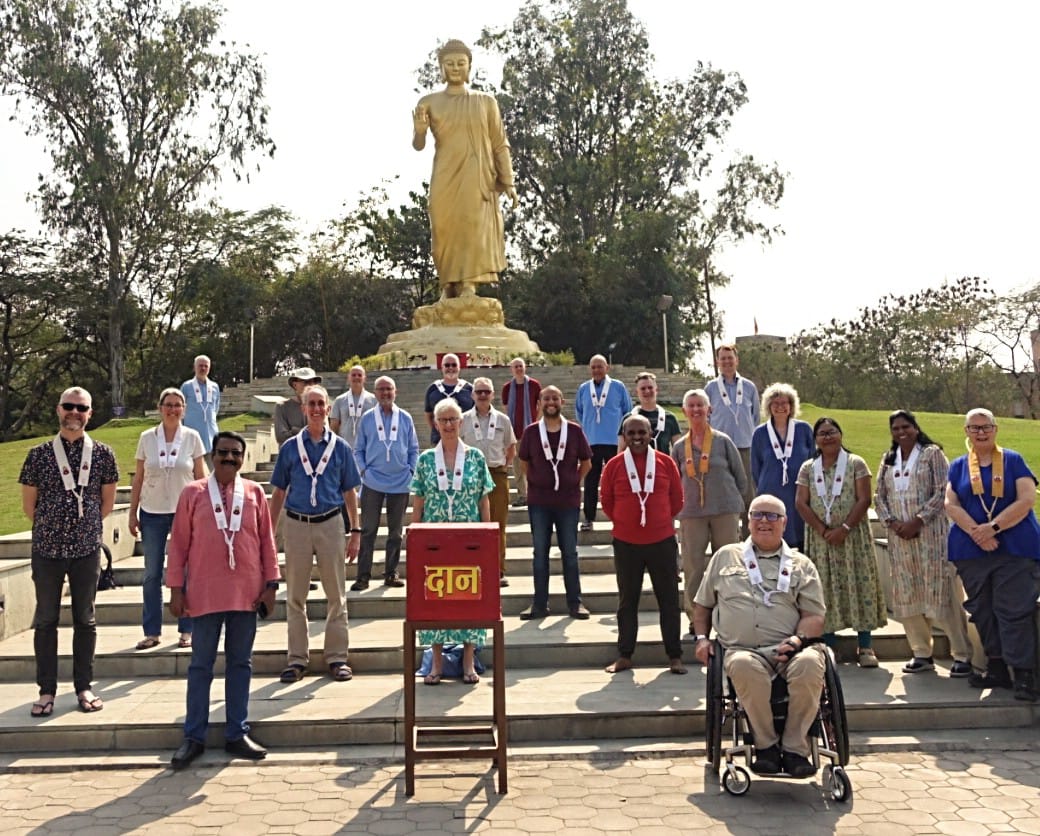
Background
At our previous in-person meeting at Adhisthana (November 2022), we successfully reviewed the International Council’s (IC) purpose, established its priorities, and updated its working arrangements. At subsequent online meetings we explored some of these priorities, but struggled to translate them into concrete actions.
In November, Mahamati succeeded Ratnadharini as chair. A key figure in the IC’s founding in 2011, he has a deep understanding of its crucial role in fostering cohesion and unity within our international movement. Prior to our meeting at Nagaloka, he clearly stated his desire to introduce himself and his vision to the IC. He also wanted this gathering to be enjoyable and to achieve tangible outcomes, ideally without excessive reliance on flipcharts!
Most members traveled to Nagaloka following their attendance at the International Order Convention in Bodh Gaya. Nagaloka (in Nagpur, central India) provides intensive, residential Dharma and social empowerment training programs for young men and women from different states across India. On our first evening, Maitreyanath, the Director of Nagaloka, led us on a comprehensive tour of the well-maintained 15-acre campus. At its heart stands a striking 11-meter tall golden walking Buddha. Directly facing him, in the distance, is an elevated brass statue of Dr. Ambedkar.
This setting was ideal for our meeting’s theme of Vision and Transformation.
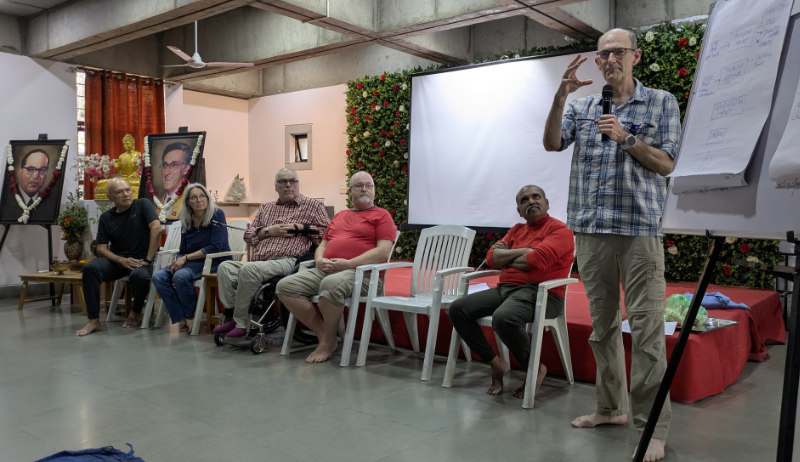
(we did have some flip-charts, sorry)
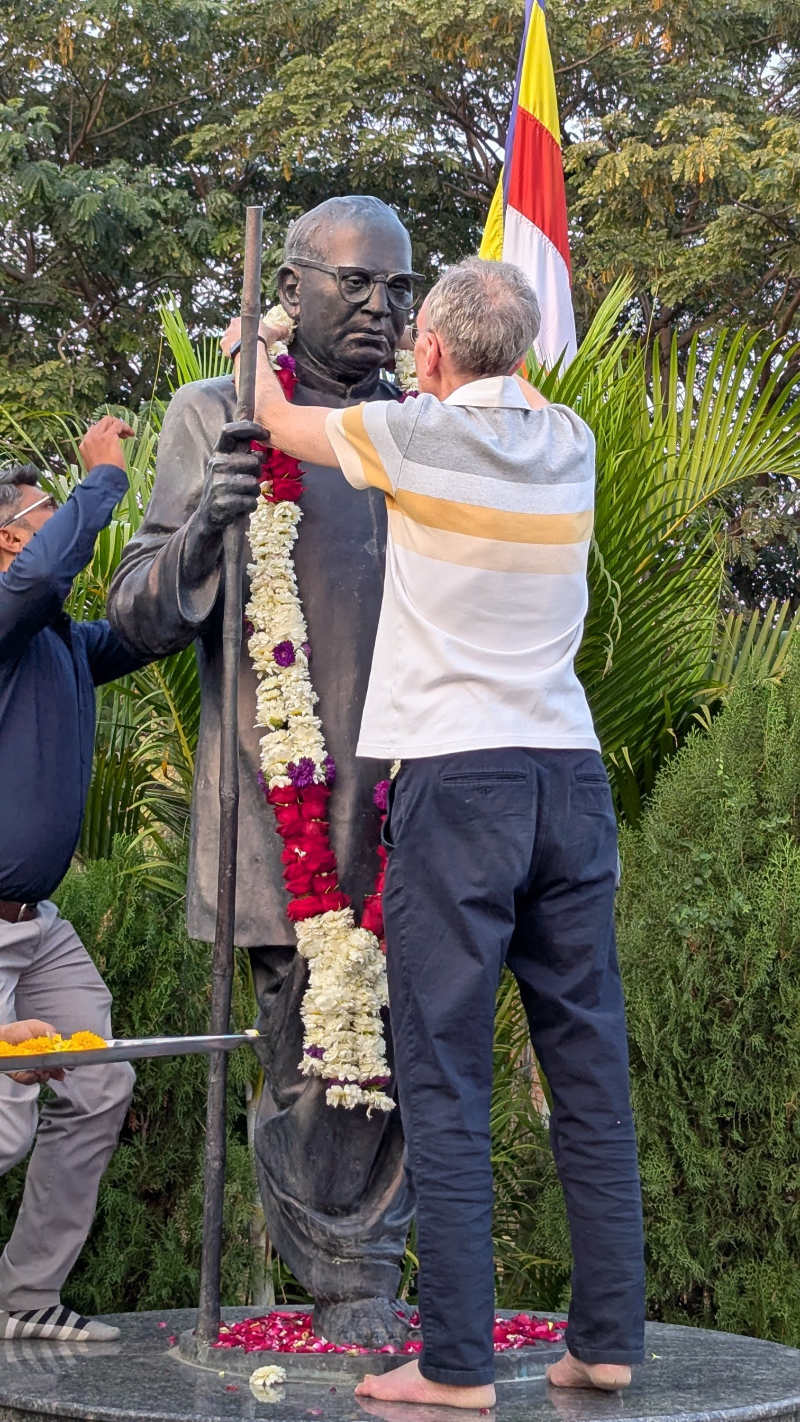
Overview
The meeting followed a generally consistent structure, with just a few exceptions. One of these was an inspiring day near the end when we visited:
- Deekshabhumi, where Dr. Ambedkar and approximately 400,000 followers converted to Buddhism on October 14, 1956
- a site in the country intended for a new women’s retreat centre
- and Sudarshanabhumi, a beautiful new retreat centre, where we enjoyed a delicious lunch
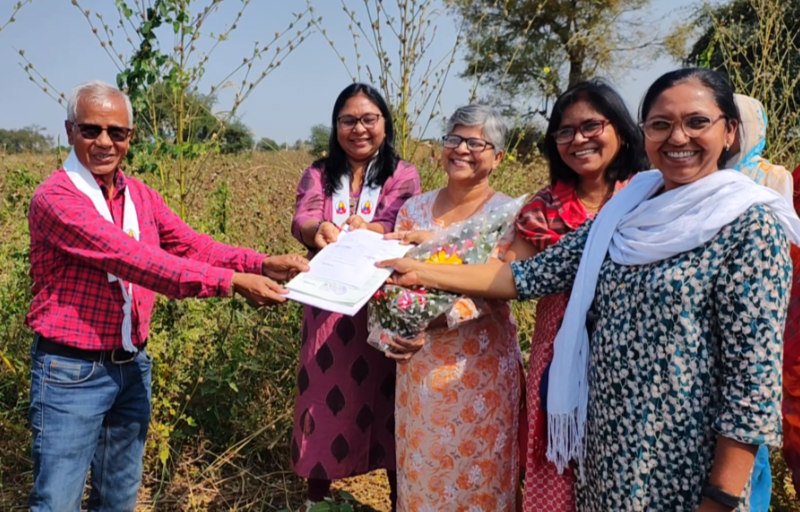
Dhammachari Nagabhadra ritually hands over the land deeds for women’s retreat centre
Each morning began with meditation in an airy ten-pillared shrine room, designed to resemble a verdant cave.
After breakfast, to commemorate Bhante’s birth centenary, we heard concise presentations on chosen aphorisms and brief excerpts from his writing which we then studied in chapters.

IC at the Deekshabhumi
Parami spoke about...
To me, it seems more obvious than ever that if we are to generate enough enthusiasm and inspiration to enable us to break through the bonds of our own individualism, as well as through the strongly anti-spiritual tendencies of modern life itself, we need the Bodhisattva Ideal. Only the Bodhisattva Ideal can carry us beyond ourselves and the world – and back again into them on a totally different basis. (Correspondence)
Amogharatna spoke about...
You can only lead a simple life if you remember what life is really for. The purpose of simplicity is not to let the business of living get in the way of the things that are of importance. (Seminar on ‘The Door Of Liberation) (See also: What we need is more and more of less and less)
Abhayadana spoke about...
The Dharma cannot be taught; it can only be caught. You have to catch the spirit of religion, and you do that through the influence of other people. (Buddhism and Education. Lecture)
Jnanacandra spoke about...
Speaking personally, I do not want disciples who are meek and obedient and afraid to speak their mind. I want disciples who are bold, self-confident, and independent and who are capable of standing against the whole world if necessary. (Correspondence)
Vajrashura spoke about...
The good is very often the enemy of the best. (Seminar on The Stability of Societies)
Jnanadhara spoke about...
Formerly, one needed courage to attack institutions. Now one needs courage to defend them – and still more courage to create them. (Aphorism)
Most days, we focused on exploring key IC strategic priorities and determining action steps.
We also heard from Candradasa and Dayaketu about the future of the Dharma online in light of new technologies (which had been specifically requested by the IC membership), and about Future Dharma’s ‘Work A Day For The Dharma’ initiative presented by Nandavajra. Finally, there were opportunities for Strands and (where possible) Area Councils to meet.
In the evenings, we either participated in puja or enjoyed Maitreyanath and Amrutdeep being interviewed.
Towards the end of our time together, Amoghavajra hosted a cultural evening filled with entertaining, talented, and surprising performances. Sadly, this was not recorded (although some might be relieved).
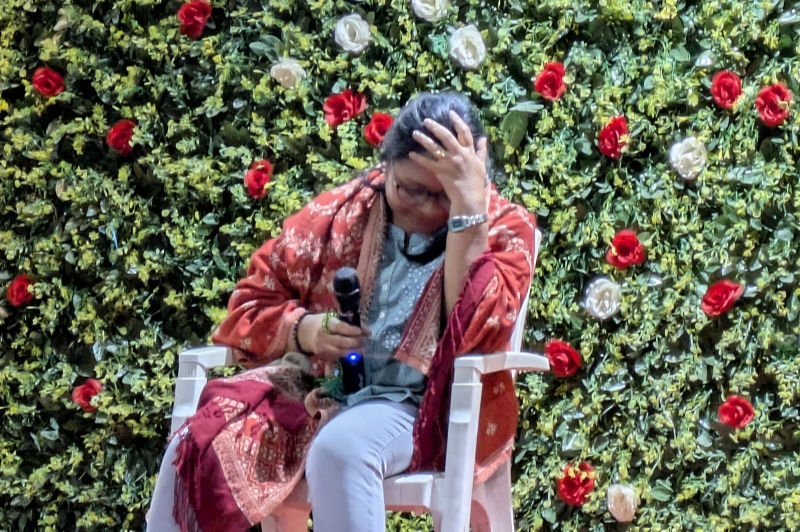
Abhayadana being dramatic! (as part of the cultural evening)
The first day...
On the first full day of the meeting, Arthavadin provided an overview of the IC’s activities since 2021 (sorry the sound isn’t so good on this) and Mahamati presented his thoughts on the importance of the IC, its future trajectory, and its potentially synergistic relationship with the newly formed College Chairs Council.
Discussions and actions
IC Strategic Priority 1:
The Path of Responsibility
At our April 2023 online meeting we explored how to deepen the spiritual experience of the Path of Responsibility. At that meeting, the IC generated seventeen insightful ideas, which the (then) Steering Group subsequently prioritised for their potential impact. The top-ranked suggestion was to revitalise the New Society as a compelling and relevant vision to inspire those taking, and thinking about taking, responsibility within Triratna – both now and in the future. Recognising that the New Society had been a recurring theme at previous IC gatherings, but never formally explored, the (current) Steering Group agreed that it would be helpful to give it focused attention.
Recently appointed College Deputy Vajrashura delivered a thought-provoking presentation to introduce the New Society theme. His central message was that the New Society remains a clear and relevant vision for Triratna but we need to find new and different ways to realise it. He proposes that the New Society should provide contexts of daily transformative intensity, beyond what are currently available. Vajrashura concluded by inviting the Strands to consider the following questions:
The 3 Cs in your Strand or situation:
- are they alive, supported, valued?
- any new ways for them to manifest?
- what channels are there for people to experience the New Society nowadays?
- where will people get the kinds of intensity that we’ve benefitted from and that have shaped us into the person we are today?
- what can those of us outside of India learn from what we see here?
- what will your strand do to bring the New Society to life in the present age?
Following a period of discussion, each strand fed back its reflections and actions that will be taken.
College Actions
- before November, all College kulas will listen to Vajrasura’s talk for discussion at College meeting
- College members will explore radical lifestyles of ordinands
- Mahamati will give a talk at May’s Presidents meeting drawing on the content of Vajrasura’s presentation, and also at ECA College space
Order Actions
Discussion focussed on how we can support chapters to be vibrant and spiritually effective in deepening Kalyanamitrata.
1. Create a space on the order website dedicated to resources for chapters and chapter convenors. Dharmaraja will start the necessary conversations and be the driving force behind this.
2. Create short videos where effective and spiritually vibrant chapters share their inspiration, experience and approach. These videos will be shared through the order convening channels. Satyalila will speak to her chapter and ask if they would be willing to produce the first video (about 15 minutes), perhaps then inviting another chapter to do the same.
3. In Mexico start a wider conversation about the New Society and its relation to chapter life. Medhavin will bring the topic to the Mexican chapter convenors’ meeting.
4. Revive the practice of confessions in chapters and its potential as insight practice. Amogharatna will produce a resource on this or find some way to address this.
5. Chapter twinning was brought up: two chapters exchanging experiences, best practice, being in dialogue and inspiring each other. No concrete action on this was yet decided on.
Movement Actions
1. Look at links/implications for other bodies ie College Chairs Council.
2. Ask ECA to have time to focus on this.
3. ECA to have a Groups/pioneers coordinator.
4. Find a way to tell story of Nagaloka as example of radical vision
IC Strategic Priority 1 (sub-element):
Decision-making
In September 2023, the International Council (IC) met online to establish principles for decision-making and to explore a universal decision-making model for Triratna. While the meeting produced valuable information, the aspiration of a universal model proved overly ambitious.
Recognising the IC’s lack of a clear decision-making model, which could undermine the legitimacy of its decisions, the Steering Group remained committed to addressing this strategic priority. Bodhivamsa was tasked with developing a proposal for discussion at Nagaloka.
Despite feeling unwell, Bodhivamsa led an informative and engaging workshop. This included an introduction to decision-making, a group exercise illustrating the challenges of achieving pure consensus, a review of the 2023 IC meeting (noted above), and a suggested decision-making model for the IC.
The IC saw potential in Bodhivamsa’s proposal but felt it required further refinement. Consequently, Vajrapriya, Jnanacandra, and Arthavadin formed a working group and, several days later, presented a revised recommendation. This received strong support from the IC, though suggestions for a few further improvements were made. The Steering Group will incorporate these suggestions before submitting the amended decision-making process to Area Councils for consent.
A discussion of the revised decision-making process can be found at 11:30 in the 2nd video. The first part of that video has Parami introducing or reminding us about the International Course. Please note that the College is seeking nominations from Area Councils for the summer 2026 course at Adhisthana (see video).
IC Strategic Priority 2:
Develop effective communications
The September 2023 IC online meeting started exploring Triratna’s communications, specifically how to effectively communicate Triratna to the world. The membership was clear about what it wanted to communicate and how it wanted this to happen. However, it also recognised that communications covers such a broad spectrum of activities and that these needed to be prioritised.
At Nagaloka Candradasa and Dayaketu gave a comprehensive presentation of how the Buddhist Centre Online is meeting a wide range of Triratna’s online communications (and other) needs, as well as laying out the pressing financial challenges that threaten its continuing operation and future development.
They asked the meeting to consider the following questions:
- does the IC still want to hold overall responsibility for Triratna online and its funding?
- what would it look like to you in your strand for Triratna to succeed online?
- if we are to serve a vision of the New Society well we need a new conversation about how we fund central Triratna spaces and services online. Whichever version of the future appeals to you, how can your strand invest in and support this work?
- how do we become a credible exemplifying force for good online at the scale Bhante envisaged?
and received feedback (see 2nd video)
Arthavadin facilitated a communications prioritisation exercise, where members were individually requested to choose, in priority order, five ideas from the wide-ranging list generated at the September 2023 IC zoom meeting noted above. (Candradasa, Dayaketu and other guests were requested not to attend this session.)
In priority order, the membership identified the following four communications issues as the most important, especially the first priority which received a significantly greater weighting than those that follow it.
The Steering Group agreed to address these priorities and will feed back to the IC on progress later this year.
Communication Priorities
- identify who or what should take the lead on Triratna’s communications
- establish clarity and consistency around key messages that we want to communicate about Triratna
- establish sustainable funding for TBCO
- establish effective means of translating important internal and external communications into Spanish and Hindi (as well as English)
IC Strategic Priority 4:
Wealth creation and management
Wealth creation and management is the IC’s fourth strategic priority. It aims to generate, liberate, and invest financial resources to fund Triratna’s essential institutions.
Nandavajra, Director of FutureDharma, was invited to explore this priority with the IC. There was no expectation that this initial exploration would result in definite actions although, as can be seen below, some were generated.
Nandavajra gave a brief presentation which included the sharing of an unofficial diagram which helpfully illustrates the organisational flow of funds within and across Triratna.

He then invited the three Strands to map out the financial ‘ecology’ for their strand, exploring how it is funded, and to determine whether such funding is sustainable. He also suggested that the Strands could, if they wished, conduct a SWOT analysis to identify the strengths, weaknesses, opportunities and threats relating to sustainable strand funding. Several other questions were asked relating to each Strand’s vision, with ideas and potential next steps, for funding and abundance; and to explore how the Strand exists within a wider organisational system, identifying opportunities for synergy, collaboration and new income generation projects.
The outputs of each Strand (below) potentially provide a basis for further discussions and possible actions to progress the wealth creation and management priority.
College Strand SWOT:
Strengths:
- institutions keen to support us
- large number of mitras training for ordination = potential donors
- can ask Centres for money when people ordained
- very visible – without college, no OMs
legacies
Weaknesses:
- taken for granted at times (eg travel to Guhyaloka)
- lack of a fundraising strategy and communication outside India
- perception that the College is only concerned with mitras (eg stopping standing orders after ordination)
- reluctance to mix fundraising with KM relationships
- lack of clarity about mitras covering Preceptors costs
- Public preceptors having to spend too much time fundraising (India)
Opportunities:
- could ask to include College costs/donations in Order retreat costs eg 10%
- opportunity is ordination retreats
Threats:
- FCRA (India)
- media scandal
- lots of other fundraising going on
economic factors eg inflation
Order Strand SWOT
Strengths:
- dana based, practice opportunity
- fundraising
Weaknesses:
- life subscriptions (India)
- lack of culture of giving (India)
- Order Dana promoting (regionally)
- visibility of giving (statistical?)
- informal funding for Areas
Opportunities:
- educate Order what the IC does
- educate Order (already giving)
- education future Order
- multi channel promotion
Threats:
- many calls on OM funds
- economic pressures
- political instability
Movement Strand reflections
What is needed?
- inspiring vision
- understand spiritual opportunities of serving the institutions and their vital importance
- key stakeholders involved and engaged, internationally aware
- find urgency
- build sense of joining a bigger project beyond local Centre (co-creation)
- success requires significant participation from all
- educate MCs so they can educate mitras
- educate the Order
What are the key issues?
- Order seems reticent to talk about money
- when the ‘ask’ is clear, we get a good response
- asking for ‘operational money’ is not seen as ‘sexy’
Identify realistic ways forward:
- we are not being radical enough
- we need different funding models
- we need a good business eg a new Windhorse
- we don’t have enough diversity in income streams
- the current cost of funds will eventually throttle our work
Identify three immediate actions:
- identify internal and external talent to look at best practice, revenue streams for ‘profit with purpose’ organisations. Explore alternative income generation. Eg yogi Tea, Sanitarium, …Jeans all owned at some point by spiritual organisations
- look and collect ‘best practice’ – fundraising practices that can help explore untapped potential eg bequests, foundations, grants etc
- communicate the vision, explore our altruistic dimension, create a culture of giving. Tell successful stories, case studies of social enterprises and fundraising. Look to provide mitra/ordination training/Order context on ‘giving’ and why is important to our practice and 3 strands
Later, Nandavajra invited the membership, in different (non-Strand) groupings, to consider these questions:
What are the key financial issues/needs for our institutions?
What can be done to address them?
Funding issues to be addressed
• do we have a vision that is so compelling that people want to give financially to support and realise it?
• serving our institutions needs to be integral to our vision
• we are not thinking big enough about how to generate sources of revenue
• have we explored the potential of untapped possibilities – eg. grant funding?
• pros and cons of centralised/decentralised fundraising
• reluctance to be bold around money
• we need to find ways to develop a greater sense of urgency around this issue
• (India) lack of proper systems around funding for the institutions
• (India) loss of FCRA is negatively impacting the funding of institutions
• (India) most Order members do not take responsibility within the institutions after ordination which burdens the minority who do
Potential Actions
• look externally to how other religious and spiritual movements have created ethical income streams
• harness ‘best practices’ around fundraising and roll out to all Areas
• educate newcomers, mitras, GFR mitras, Order members around the altruistic dimension of GFR, culture of giving, increase understanding about importance of funding our institutions and how
• develop an inspiring vision that people want to support financially – a vision that gives people a sense of joining and being part of something bigger than themselves. IC could devote more time and attention to this. Alternatively, draw together key stakeholders and ‘multipliers’ and ‘influencers’ into a working group (ensure internationally aware and not UK-centric)
• research says that spiritual communities thrive when there is a high level of participation by all. Find ways to encourage this
• encourage the development of bold projects that have the potential to become ‘cash cows’ – possibly at least one in each Area
• seek crowd funding to invest in projects rather than relying solely on dana
• request FutureDharma to review the extent to which the centralisation of fundraising is working and explore with the IC
• (India) discuss the creation of proper systems to fund/finance the institutions
• (India) develop training for the Order to encourage the taking of institutional responsibility after ordination. The Indian College and Order will work together to achieve this
IC Priority 8: Dharmic engagement with social and ecological issues
Arthavadin fed back to the membership that after a long, and at times challenging, process the ‘Guidelines on Buddhist Social Action’ have now received consent from all six Area Councils. The Steering Group is keen that after so much hard work these guidelines are discussed and explored within Areas and Strands so that they are widely known and brought to life as a helpful resource. Arthavadin, on behalf of the Steering Group, Area Councils are requested to send ideas about how to achieve this to him in the next few weeks (or his successor if after April). The Steering Group will collate and consider all ideas, and report an agreed way forward.
Area Council meetings
Area Councils (that had sufficient members present) at Nagaloka met to discuss issues within their Areas. They were requested to consider and share with the meeting their top tips and ideas for an efficient and effectively functioning Area Council .
Click on the box below for the collated list of their suggestions:
Suggestions about Area Councils
- meet often enough to maintain momentum
- meet in person at least once a year
- ACs to share agenda/mins with Steering group
- induction for new members – help them get up to speed on ongoing issues/processes, be welcoming
- invite guests, stimulates discussion
- feedback to ACs about steering group
- AC convenors and IC convenor to stay in touch
- let IC convenor know when AC meetings are happening
- AC newsletter? Put on IC website?
- new OMs – how can they hear about AC? Make yourself visible
- how to select the right people for IC?
- idea of co-opting Mitra Convenors to AC?
- AC could organise larger 3-strand meetings
- how to have IC information in Hindi? (Amrutdeep happy to be a contact for translation)
- IC app? or something useful on phone
The three Strands also met to discuss issues relevant to their strand. No feedback from these meetings was sought or offered.
The final day: meeting evaluation, appreciations and farewells
On the final day, Parina and Jnanacandra generously conducted an evaluation of the meeting by asking members what they liked and found effective, and what they wished to be different.
In the evening, Mahamati thanked the members for their attendance and wholehearted participation. He acknowledged everyone who had contributed to the meeting’s preparation and success, including Nagaloka’s exceptionally responsive and efficient kitchen and housekeeping teams.
Arthavadin, who will step down from his role as IC Convenor at the end of April, was warmly celebrated and rejoiced in. He received cards expressing appreciation, along with a scaled-down, yet substantial, replica of the large walking Buddha rupa that stands at the heart of Nagaloka. Arthavadin thanked the members for their generosity and kindness, and specifically acknowledged Aparajita and others who have assisted him over the past four years. Finally, Arthavadin expressed his confidence in Mahamati as the chair of the IC and encouraged everyone to support him.
The meeting concluded with a transference of merit and self-surrender.
What was liked
In summary, members stated that they valued the meeting’s blend of spiritual depth (morning study, ‘New Society’ discussions) and practical outcomes (decision-making process, wealth management). Mahamati’s vision, Candradasa’s technology insights, and Vajrasura’s ‘New Society’ presentation were particularly impactful, leading to concrete action points. The participatory nature of sessions like the wealth creation fishbowl and the focus on Area Council best practices were also praised, resulting in a well-received and effective program.
What could have been different
In terms of what members would like to be different, they said they would like to see enhanced participation and preparation, including improved attendance, advanced communication about the themes to be explored, and pre-meeting materials. Ideally, they would appreciate more focused discussions and deeper explorations of fewer topics, and more integration of Dharma practice. Streamlining meeting flow, clarifying online meeting expectations, and increasing accessibility through translations and subsidies were also noted as priorities. Strengthening Area Council engagement and ensuring clear public communication about the IC’s work were expressed as key requests.
Conclusion
The International Council’s meeting at Nagaloka began to successfully bridge the gap between strategic aspirations and practical actions. It fostered invaluable in-person connections and reinforced the kalyana mitrata that unites us despite living and working in different parts of the world.
Significant strides were made in clarifying the IC’s decision-making process, and in addressing Triratna’s communications. Notably, the meeting reignited the vision of the New Society, prompting insightful discussions and concrete actions across the College, Order, and Movement Strands. Furthermore, we began to delve into the crucial area of wealth creation and management, planting seeds that will hopefully sprout into initiatives that secure the financial sustainability of our key structures and institutions.
Beyond the specific agreements and action plans, the meeting’s success lay in its ability to inspire. The rich tapestry of experiences gained from spending ten days in close proximity – meditating, practicing and eating together; exploring Bhante’s aphorisms and, and simply enjoying a day out, and entertaining each other at our cultural evening—created a shared context for meaningful dialogue. Although we have now returned to our respective homes, we carry with us a renewed sense of purpose. By translating collective aspirations into tangible actions, and by nurturing the bonds of spiritual friendship, each and every member has played a small but important part in maintaining and strengthening the IC, and therefore Triratna. Thank you.
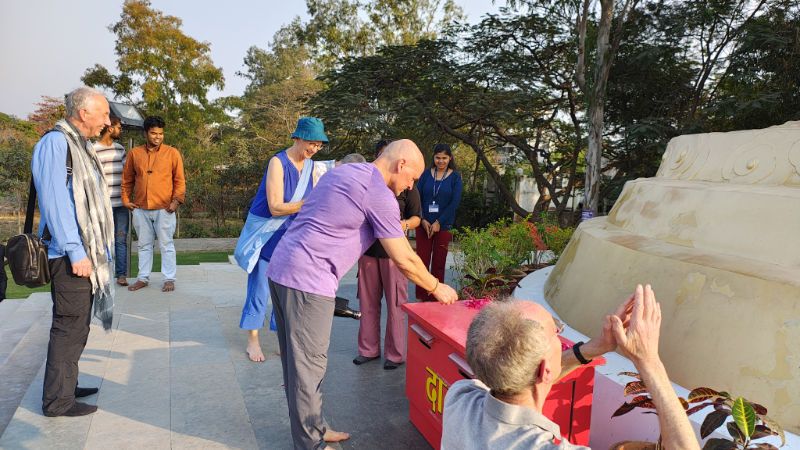
Making offerings to the magnificent walking Buddha
